Forest, OH Map & Demographics
Forest Map
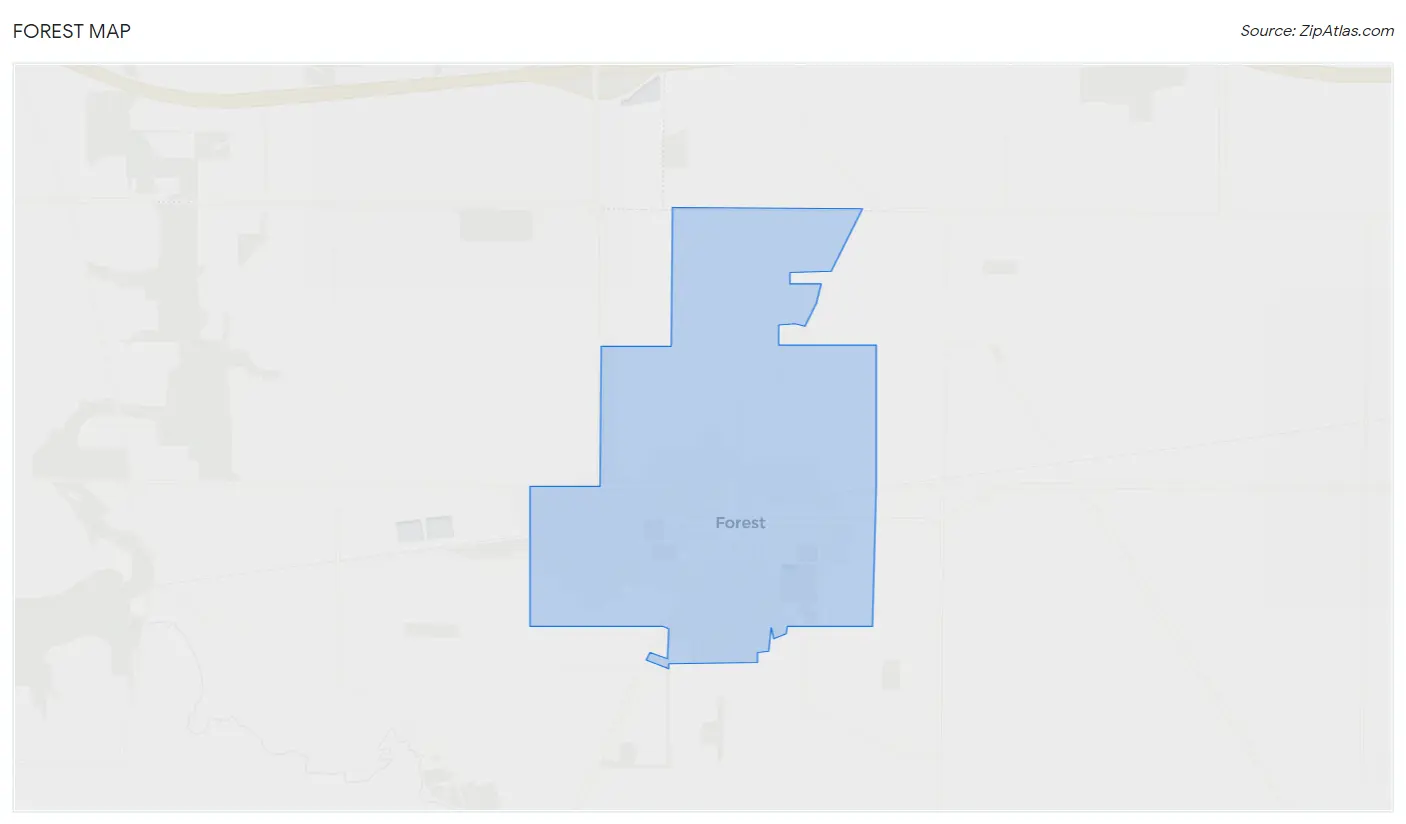
Forest Overview
$24,740
PER CAPITA INCOME
$53,750
AVG FAMILY INCOME
$46,731
AVG HOUSEHOLD INCOME
44.3%
WAGE / INCOME GAP [ % ]
55.7¢/ $1
WAGE / INCOME GAP [ $ ]
0.40
INEQUALITY / GINI INDEX
1,455
TOTAL POPULATION
712
MALE POPULATION
743
FEMALE POPULATION
95.83
MALES / 100 FEMALES
104.35
FEMALES / 100 MALES
37.3
MEDIAN AGE
2.9
AVG FAMILY SIZE
2.4
AVG HOUSEHOLD SIZE
812
LABOR FORCE [ PEOPLE ]
73.1%
PERCENT IN LABOR FORCE
3.1%
UNEMPLOYMENT RATE
Forest Zip Codes
Forest Area Codes
Income in Forest
Income Overview in Forest
Per Capita Income in Forest is $24,740, while median incomes of families and households are $53,750 and $46,731 respectively.
| Characteristic | Number | Measure |
| Per Capita Income | 1,455 | $24,740 |
| Median Family Income | 426 | $53,750 |
| Mean Family Income | 426 | $67,135 |
| Median Household Income | 602 | $46,731 |
| Mean Household Income | 602 | $60,553 |
| Income Deficit | 426 | $0 |
| Wage / Income Gap (%) | 1,455 | 44.31% |
| Wage / Income Gap ($) | 1,455 | 55.69¢ per $1 |
| Gini / Inequality Index | 1,455 | 0.40 |
Earnings by Sex in Forest
Average Earnings in Forest are $31,667, $44,107 for men and $24,563 for women, a difference of 44.3%.

| Sex | Number | Average Earnings |
| Male | 401 (47.8%) | $44,107 |
| Female | 437 (52.1%) | $24,563 |
| Total | 838 (100.0%) | $31,667 |
Earnings by Sex by Income Bracket in Forest
The most common earnings brackets in Forest are $55,000 to $64,999 for men (61 | 15.2%) and $10,000 to $12,499 for women (59 | 13.5%).
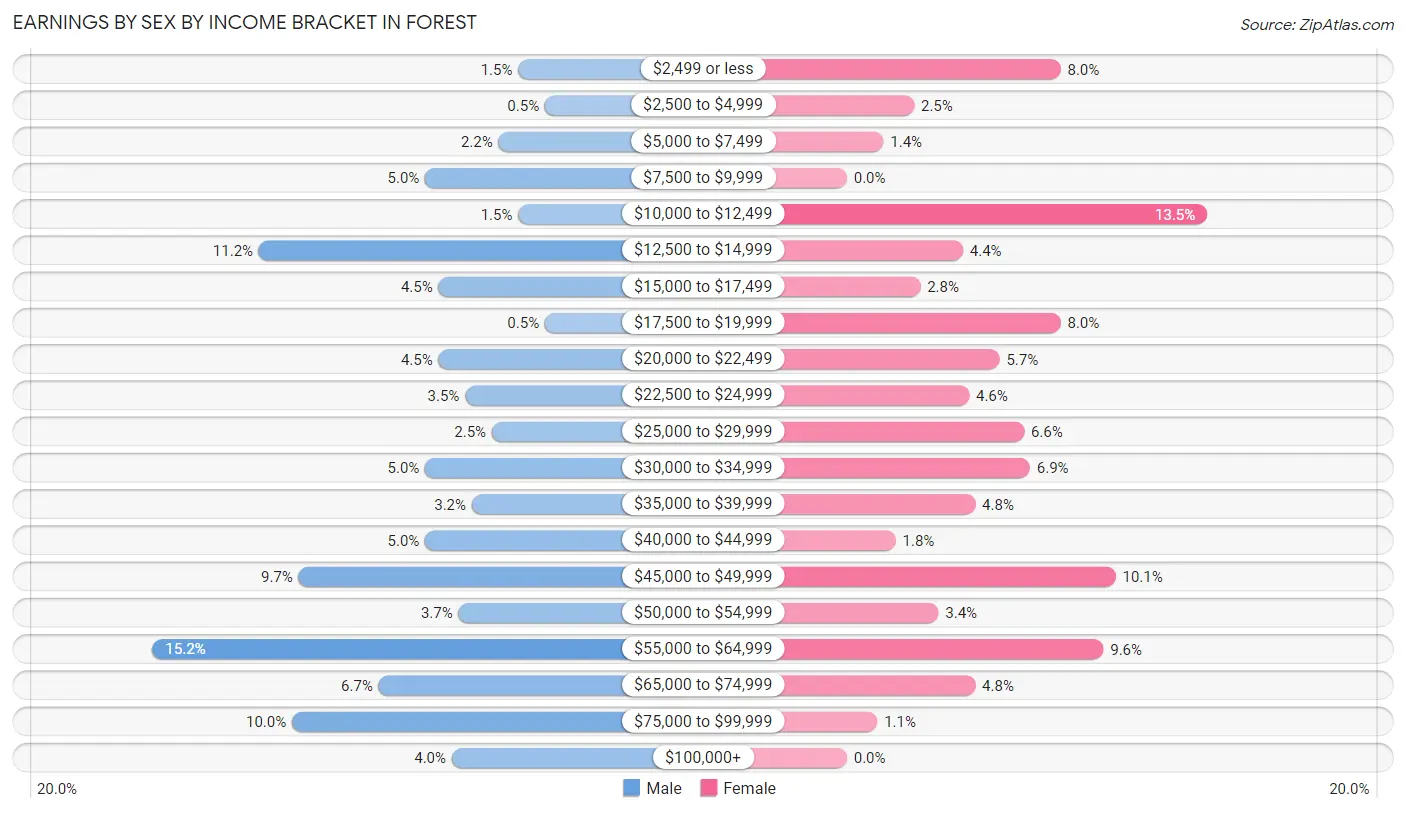
| Income | Male | Female |
| $2,499 or less | 6 (1.5%) | 35 (8.0%) |
| $2,500 to $4,999 | 2 (0.5%) | 11 (2.5%) |
| $5,000 to $7,499 | 9 (2.2%) | 6 (1.4%) |
| $7,500 to $9,999 | 20 (5.0%) | 0 (0.0%) |
| $10,000 to $12,499 | 6 (1.5%) | 59 (13.5%) |
| $12,500 to $14,999 | 45 (11.2%) | 19 (4.3%) |
| $15,000 to $17,499 | 18 (4.5%) | 12 (2.8%) |
| $17,500 to $19,999 | 2 (0.5%) | 35 (8.0%) |
| $20,000 to $22,499 | 18 (4.5%) | 25 (5.7%) |
| $22,500 to $24,999 | 14 (3.5%) | 20 (4.6%) |
| $25,000 to $29,999 | 10 (2.5%) | 29 (6.6%) |
| $30,000 to $34,999 | 20 (5.0%) | 30 (6.9%) |
| $35,000 to $39,999 | 13 (3.2%) | 21 (4.8%) |
| $40,000 to $44,999 | 20 (5.0%) | 8 (1.8%) |
| $45,000 to $49,999 | 39 (9.7%) | 44 (10.1%) |
| $50,000 to $54,999 | 15 (3.7%) | 15 (3.4%) |
| $55,000 to $64,999 | 61 (15.2%) | 42 (9.6%) |
| $65,000 to $74,999 | 27 (6.7%) | 21 (4.8%) |
| $75,000 to $99,999 | 40 (10.0%) | 5 (1.1%) |
| $100,000+ | 16 (4.0%) | 0 (0.0%) |
| Total | 401 (100.0%) | 437 (100.0%) |
Earnings by Sex by Educational Attainment in Forest
Average earnings in Forest are $47,500 for men and $25,000 for women, a difference of 47.4%. Men with an educational attainment of bachelor's degree enjoy the highest average annual earnings of $90,750, while those with college or associate's degree education earn the least with $18,750. Women with an educational attainment of graduate degree earn the most with the average annual earnings of $56,042, while those with high school diploma education have the smallest earnings of $23,594.

| Educational Attainment | Male Income | Female Income |
| Less than High School | $48,750 | $0 |
| High School Diploma | $59,375 | $23,594 |
| College or Associate's Degree | $18,750 | $24,063 |
| Bachelor's Degree | $90,750 | $33,462 |
| Graduate Degree | $57,083 | $56,042 |
| Total | $47,500 | $25,000 |
Family Income in Forest
Family Income Brackets in Forest
According to the Forest family income data, there are 73 families falling into the $50,000 to $74,999 income range, which is the most common income bracket and makes up 17.1% of all families. Conversely, the $10,000 to $14,999 income bracket is the least frequent group with only 14 families (3.3%) belonging to this category.

| Income Bracket | # Families | % Families |
| Less than $10,000 | 16 | 3.8% |
| $10,000 to $14,999 | 14 | 3.3% |
| $15,000 to $24,999 | 34 | 8.0% |
| $25,000 to $34,999 | 70 | 16.4% |
| $35,000 to $49,999 | 67 | 15.7% |
| $50,000 to $74,999 | 73 | 17.1% |
| $75,000 to $99,999 | 62 | 14.6% |
| $100,000 to $149,999 | 52 | 12.2% |
| $150,000 to $199,999 | 24 | 5.6% |
| $200,000+ | 14 | 3.3% |
Family Income by Famaliy Size in Forest
4-person families (72 | 16.9%) account for the highest median family income in Forest with $115,500 per family, while 4-person families (72 | 16.9%) have the highest median income of $28,875 per family member.

| Income Bracket | # Families | Median Income |
| 2-Person Families | 238 (55.9%) | $41,042 |
| 3-Person Families | 30 (7.0%) | $63,125 |
| 4-Person Families | 72 (16.9%) | $115,500 |
| 5-Person Families | 74 (17.4%) | $64,643 |
| 6-Person Families | 12 (2.8%) | $0 |
| 7+ Person Families | 0 (0.0%) | $0 |
| Total | 426 (100.0%) | $53,750 |
Family Income by Number of Earners in Forest
The median family income in Forest is $53,750, with families comprising 3+ earners (50) having the highest median family income of $151,250, while families with no earners (59) have the lowest median family income of $36,458, accounting for 11.7% and 13.9% of families, respectively.

| Number of Earners | # Families | Median Income |
| No Earners | 59 (13.9%) | $36,458 |
| 1 Earner | 125 (29.3%) | $40,938 |
| 2 Earners | 192 (45.1%) | $63,864 |
| 3+ Earners | 50 (11.7%) | $151,250 |
| Total | 426 (100.0%) | $53,750 |
Household Income in Forest
Household Income Brackets in Forest
With 113 households falling in the category, the $25,000 to $34,999 income range is the most frequent in Forest, accounting for 18.8% of all households. In contrast, only 14 households (2.3%) fall into the $200,000+ income bracket, making it the least populous group.

| Income Bracket | # Households | % Households |
| Less than $10,000 | 44 | 7.3% |
| $10,000 to $14,999 | 17 | 2.8% |
| $15,000 to $24,999 | 37 | 6.1% |
| $25,000 to $34,999 | 113 | 18.8% |
| $35,000 to $49,999 | 107 | 17.8% |
| $50,000 to $74,999 | 101 | 16.8% |
| $75,000 to $99,999 | 88 | 14.6% |
| $100,000 to $149,999 | 57 | 9.5% |
| $150,000 to $199,999 | 24 | 4.0% |
| $200,000+ | 14 | 2.3% |
Household Income by Householder Age in Forest
The median household income in Forest is $46,731, with the highest median household income of $62,614 found in the 25 to 44 years age bracket for the primary householder. A total of 219 households (36.4%) fall into this category. Meanwhile, the 65+ years age bracket for the primary householder has the lowest median household income of $37,500, with 120 households (19.9%) in this group.

| Income Bracket | # Households | Median Income |
| 15 to 24 Years | 31 (5.1%) | $41,528 |
| 25 to 44 Years | 219 (36.4%) | $62,614 |
| 45 to 64 Years | 232 (38.5%) | $48,500 |
| 65+ Years | 120 (19.9%) | $37,500 |
| Total | 602 (100.0%) | $46,731 |
Poverty in Forest
Income Below Poverty by Sex and Age in Forest
With 10.0% poverty level for males and 13.2% for females among the residents of Forest, 15 year old males and 12 to 14 year old females are the most vulnerable to poverty, with 8 males (57.1%) and 14 females (34.2%) in their respective age groups living below the poverty level.
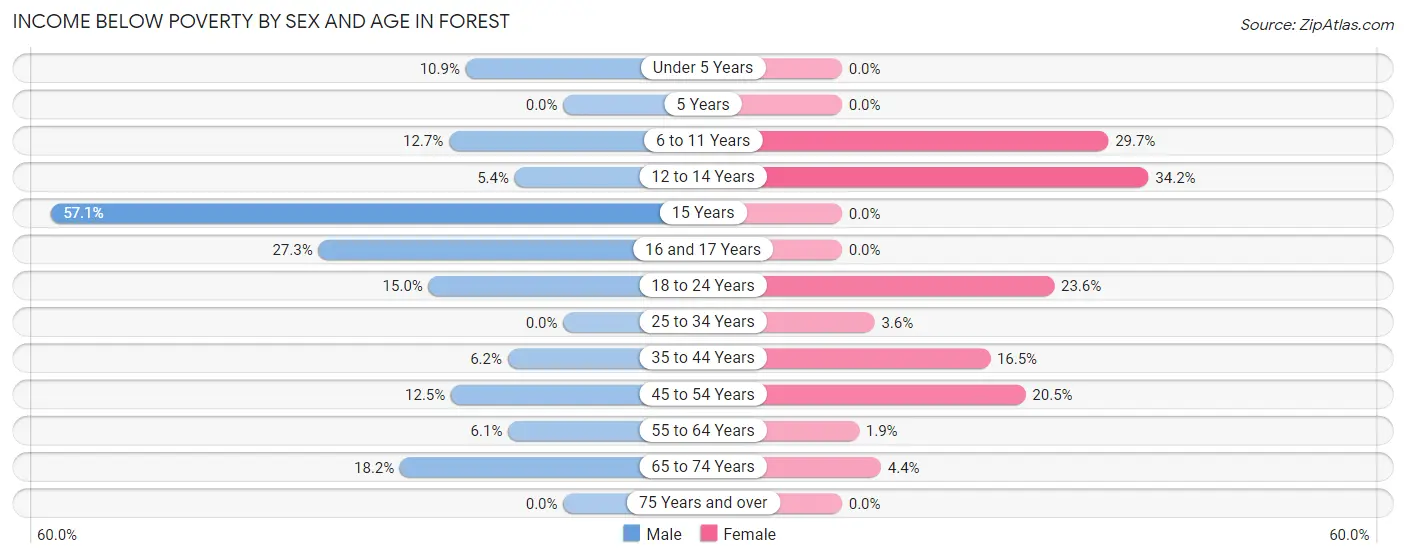
| Age Bracket | Male | Female |
| Under 5 Years | 5 (10.9%) | 0 (0.0%) |
| 5 Years | 0 (0.0%) | 0 (0.0%) |
| 6 to 11 Years | 7 (12.7%) | 27 (29.7%) |
| 12 to 14 Years | 2 (5.4%) | 14 (34.2%) |
| 15 Years | 8 (57.1%) | 0 (0.0%) |
| 16 and 17 Years | 9 (27.3%) | 0 (0.0%) |
| 18 to 24 Years | 9 (15.0%) | 13 (23.6%) |
| 25 to 34 Years | 0 (0.0%) | 4 (3.6%) |
| 35 to 44 Years | 7 (6.2%) | 17 (16.5%) |
| 45 to 54 Years | 9 (12.5%) | 18 (20.4%) |
| 55 to 64 Years | 7 (6.1%) | 2 (1.9%) |
| 65 to 74 Years | 8 (18.2%) | 3 (4.3%) |
| 75 Years and over | 0 (0.0%) | 0 (0.0%) |
| Total | 71 (10.0%) | 98 (13.2%) |
Income Above Poverty by Sex and Age in Forest
According to the poverty statistics in Forest, males aged 5 years and females aged under 5 years are the age groups that are most secure financially, with 100.0% of males and 100.0% of females in these age groups living above the poverty line.
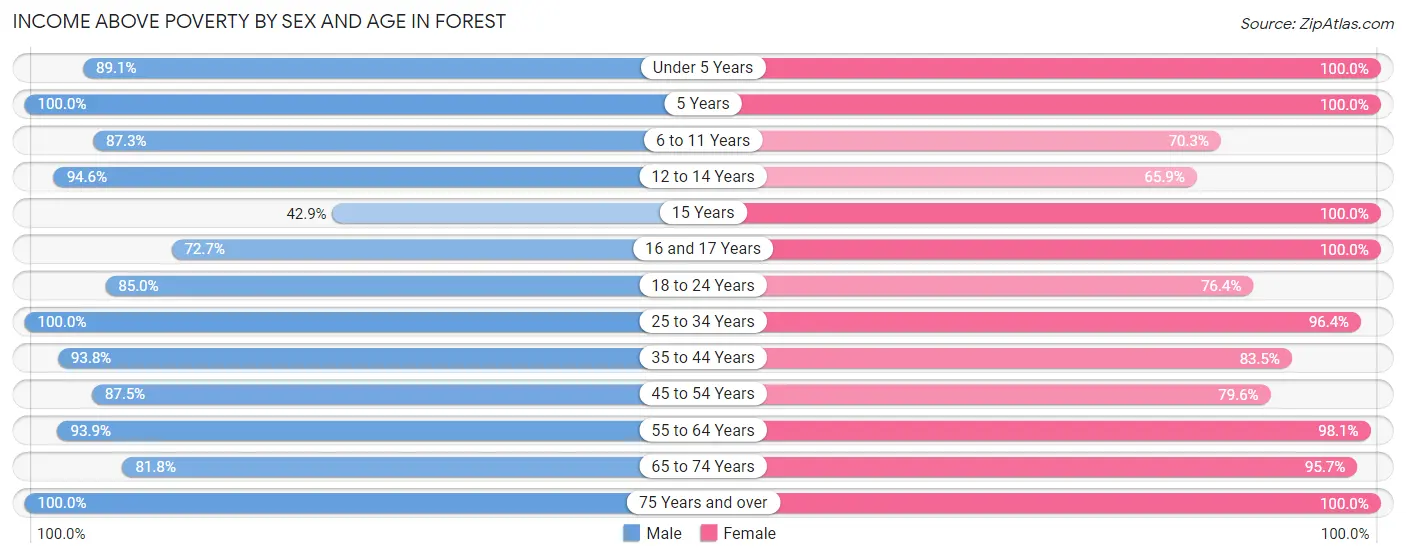
| Age Bracket | Male | Female |
| Under 5 Years | 41 (89.1%) | 7 (100.0%) |
| 5 Years | 12 (100.0%) | 18 (100.0%) |
| 6 to 11 Years | 48 (87.3%) | 64 (70.3%) |
| 12 to 14 Years | 35 (94.6%) | 27 (65.8%) |
| 15 Years | 6 (42.9%) | 23 (100.0%) |
| 16 and 17 Years | 24 (72.7%) | 5 (100.0%) |
| 18 to 24 Years | 51 (85.0%) | 42 (76.4%) |
| 25 to 34 Years | 77 (100.0%) | 106 (96.4%) |
| 35 to 44 Years | 106 (93.8%) | 86 (83.5%) |
| 45 to 54 Years | 63 (87.5%) | 70 (79.5%) |
| 55 to 64 Years | 107 (93.9%) | 103 (98.1%) |
| 65 to 74 Years | 36 (81.8%) | 66 (95.7%) |
| 75 Years and over | 35 (100.0%) | 28 (100.0%) |
| Total | 641 (90.0%) | 645 (86.8%) |
Income Below Poverty Among Married-Couple Families in Forest
The poverty statistics for married-couple families in Forest show that 1.6% or 5 of the total 309 families live below the poverty line. Families with no children have the highest poverty rate of 2.9%, comprising of 5 families. On the other hand, families with 1 or 2 children have the lowest poverty rate of 0.0%, which includes 0 families.

| Children | Above Poverty | Below Poverty |
| No Children | 168 (97.1%) | 5 (2.9%) |
| 1 or 2 Children | 74 (100.0%) | 0 (0.0%) |
| 3 or 4 Children | 62 (100.0%) | 0 (0.0%) |
| 5 or more Children | 0 (0.0%) | 0 (0.0%) |
| Total | 304 (98.4%) | 5 (1.6%) |
Income Below Poverty Among Single-Parent Households in Forest
According to the poverty data in Forest, 28.9% or 13 single-father households and 29.2% or 21 single-mother households are living below the poverty line. Among single-father households, those with 1 or 2 children have the highest poverty rate, with 13 households (41.9%) experiencing poverty. Likewise, among single-mother households, those with 3 or 4 children have the highest poverty rate, with 13 households (100.0%) falling below the poverty line.

| Children | Single Father | Single Mother |
| No Children | 0 (0.0%) | 0 (0.0%) |
| 1 or 2 Children | 13 (41.9%) | 8 (26.7%) |
| 3 or 4 Children | 0 (0.0%) | 13 (100.0%) |
| 5 or more Children | 0 (0.0%) | 0 (0.0%) |
| Total | 13 (28.9%) | 21 (29.2%) |
Income Below Poverty Among Married-Couple vs Single-Parent Households in Forest
The poverty data for Forest shows that 5 of the married-couple family households (1.6%) and 34 of the single-parent households (29.1%) are living below the poverty level. Within the married-couple family households, those with no children have the highest poverty rate, with 5 households (2.9%) falling below the poverty line. Among the single-parent households, those with 3 or 4 children have the highest poverty rate, with 13 household (76.5%) living below poverty.

| Children | Married-Couple Families | Single-Parent Households |
| No Children | 5 (2.9%) | 0 (0.0%) |
| 1 or 2 Children | 0 (0.0%) | 21 (34.4%) |
| 3 or 4 Children | 0 (0.0%) | 13 (76.5%) |
| 5 or more Children | 0 (0.0%) | 0 (0.0%) |
| Total | 5 (1.6%) | 34 (29.1%) |
Race in Forest
The most populous races in Forest are White / Caucasian (1,401 | 96.3%), Two or more Races (26 | 1.8%), and Native / Alaskan (10 | 0.7%).

| Race | # Population | % Population |
| Asian | 3 | 0.2% |
| Black / African American | 0 | 0.0% |
| Hawaiian / Pacific | 6 | 0.4% |
| Hispanic or Latino | 2 | 0.1% |
| Native / Alaskan | 10 | 0.7% |
| White / Caucasian | 1,401 | 96.3% |
| Two or more Races | 26 | 1.8% |
| Some other Race | 9 | 0.6% |
| Total | 1,455 | 100.0% |
Ancestry in Forest
The most populous ancestries reported in Forest are German (308 | 21.2%), American (258 | 17.7%), Irish (156 | 10.7%), English (145 | 10.0%), and French (60 | 4.1%), together accounting for 63.7% of all Forest residents.
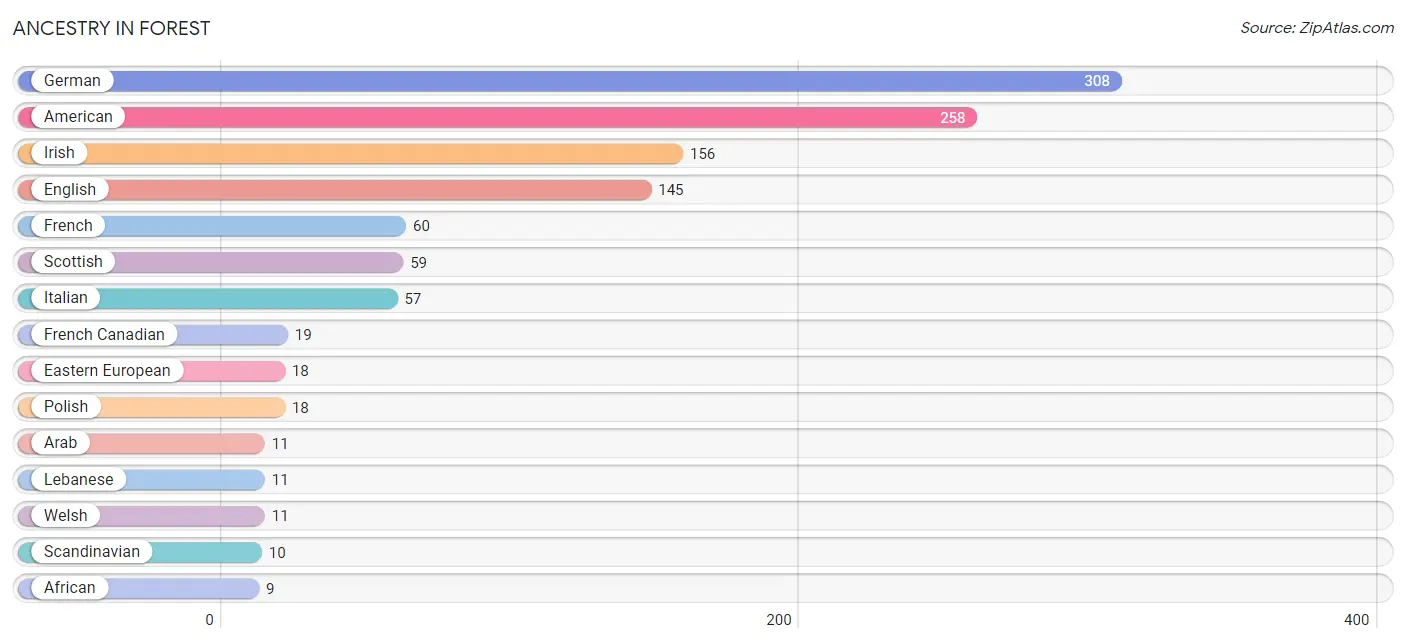
| Ancestry | # Population | % Population |
| African | 9 | 0.6% |
| American | 258 | 17.7% |
| Arab | 11 | 0.8% |
| British | 5 | 0.3% |
| Cherokee | 9 | 0.6% |
| Chippewa | 6 | 0.4% |
| Czech | 9 | 0.6% |
| Dutch | 3 | 0.2% |
| Eastern European | 18 | 1.2% |
| English | 145 | 10.0% |
| European | 6 | 0.4% |
| French | 60 | 4.1% |
| French Canadian | 19 | 1.3% |
| German | 308 | 21.2% |
| Hungarian | 9 | 0.6% |
| Irish | 156 | 10.7% |
| Italian | 57 | 3.9% |
| Lebanese | 11 | 0.8% |
| Native Hawaiian | 6 | 0.4% |
| Pennsylvania German | 6 | 0.4% |
| Polish | 18 | 1.2% |
| Puerto Rican | 2 | 0.1% |
| Scandinavian | 10 | 0.7% |
| Scottish | 59 | 4.1% |
| Slavic | 7 | 0.5% |
| Sri Lankan | 3 | 0.2% |
| Subsaharan African | 9 | 0.6% |
| Swiss | 2 | 0.1% |
| Thai | 3 | 0.2% |
| Welsh | 11 | 0.8% | View All 30 Rows |
Immigrants in Forest
The most numerous immigrant groups reported in Forest came from , and Canada (3 | 0.2%), together accounting for 0.2% of all Forest residents.

| Immigration Origin | # Population | % Population |
| Canada | 3 | 0.2% | View All 1 Rows |
Sex and Age in Forest
Sex and Age in Forest
The most populous age groups in Forest are 55 to 59 Years (75 | 10.5%) for men and 25 to 29 Years (86 | 11.6%) for women.
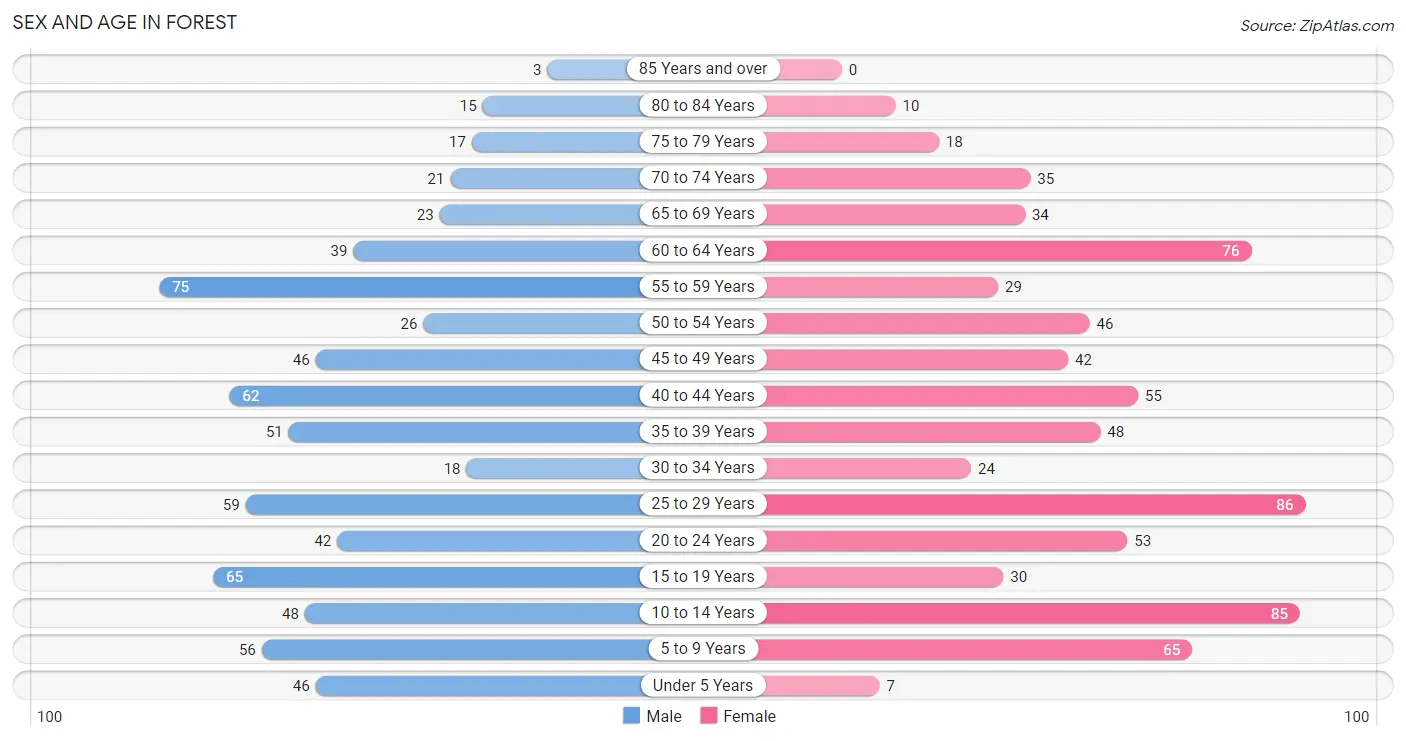
| Age Bracket | Male | Female |
| Under 5 Years | 46 (6.5%) | 7 (0.9%) |
| 5 to 9 Years | 56 (7.9%) | 65 (8.7%) |
| 10 to 14 Years | 48 (6.7%) | 85 (11.4%) |
| 15 to 19 Years | 65 (9.1%) | 30 (4.0%) |
| 20 to 24 Years | 42 (5.9%) | 53 (7.1%) |
| 25 to 29 Years | 59 (8.3%) | 86 (11.6%) |
| 30 to 34 Years | 18 (2.5%) | 24 (3.2%) |
| 35 to 39 Years | 51 (7.2%) | 48 (6.5%) |
| 40 to 44 Years | 62 (8.7%) | 55 (7.4%) |
| 45 to 49 Years | 46 (6.5%) | 42 (5.7%) |
| 50 to 54 Years | 26 (3.6%) | 46 (6.2%) |
| 55 to 59 Years | 75 (10.5%) | 29 (3.9%) |
| 60 to 64 Years | 39 (5.5%) | 76 (10.2%) |
| 65 to 69 Years | 23 (3.2%) | 34 (4.6%) |
| 70 to 74 Years | 21 (2.9%) | 35 (4.7%) |
| 75 to 79 Years | 17 (2.4%) | 18 (2.4%) |
| 80 to 84 Years | 15 (2.1%) | 10 (1.3%) |
| 85 Years and over | 3 (0.4%) | 0 (0.0%) |
| Total | 712 (100.0%) | 743 (100.0%) |
Families and Households in Forest
Median Family Size in Forest
The median family size in Forest is 2.87 persons per family, with married-couple families (309 | 72.5%) accounting for the largest median family size of 3.04 persons per family. On the other hand, single male/father families (45 | 10.6%) represent the smallest median family size with 2.18 persons per family.

| Family Type | # Families | Family Size |
| Married-Couple | 309 (72.5%) | 3.04 |
| Single Male/Father | 45 (10.6%) | 2.18 |
| Single Female/Mother | 72 (16.9%) | 2.61 |
| Total Families | 426 (100.0%) | 2.87 |
Median Household Size in Forest
The median household size in Forest is 2.42 persons per household, with married-couple households (309 | 51.3%) accounting for the largest median household size of 3.04 persons per household. non-family households (176 | 29.2%) represent the smallest median household size with 1.11 persons per household.

| Household Type | # Households | Household Size |
| Married-Couple | 309 (51.3%) | 3.04 |
| Single Male/Father | 45 (7.5%) | 2.64 |
| Single Female/Mother | 72 (12.0%) | 2.81 |
| Non-family | 176 (29.2%) | 1.11 |
| Total Households | 602 (100.0%) | 2.42 |
Household Size by Marriage Status in Forest
Out of a total of 602 households in Forest, 426 (70.8%) are family households, while 176 (29.2%) are nonfamily households. The most numerous type of family households are 2-person households, comprising 206, and the most common type of nonfamily households are 1-person households, comprising 157.

| Household Size | Family Households | Nonfamily Households |
| 1-Person Households | - | 157 (26.1%) |
| 2-Person Households | 206 (34.2%) | 19 (3.2%) |
| 3-Person Households | 53 (8.8%) | 0 (0.0%) |
| 4-Person Households | 77 (12.8%) | 0 (0.0%) |
| 5-Person Households | 78 (13.0%) | 0 (0.0%) |
| 6-Person Households | 12 (2.0%) | 0 (0.0%) |
| 7+ Person Households | 0 (0.0%) | 0 (0.0%) |
| Total | 426 (70.8%) | 176 (29.2%) |
Female Fertility in Forest
Fertility by Age in Forest
Average fertility rate in Forest is 93.0 births per 1,000 women. Women in the age bracket of 20 to 34 years have the highest fertility rate with 196.0 births per 1,000 women. Women in the age bracket of 20 to 34 years acount for 100.0% of all women with births.

| Age Bracket | Women with Births | Births / 1,000 Women |
| 15 to 19 years | 0 (0.0%) | 0.0 |
| 20 to 34 years | 32 (100.0%) | 196.0 |
| 35 to 50 years | 0 (0.0%) | 0.0 |
| Total | 32 (100.0%) | 93.0 |
Fertility by Age by Marriage Status in Forest

| Age Bracket | Married | Unmarried |
| 15 to 19 years | 0 (0.0%) | 0 (0.0%) |
| 20 to 34 years | 32 (100.0%) | 0 (0.0%) |
| 35 to 50 years | 0 (0.0%) | 0 (0.0%) |
| Total | 32 (100.0%) | 0 (0.0%) |
Fertility by Education in Forest
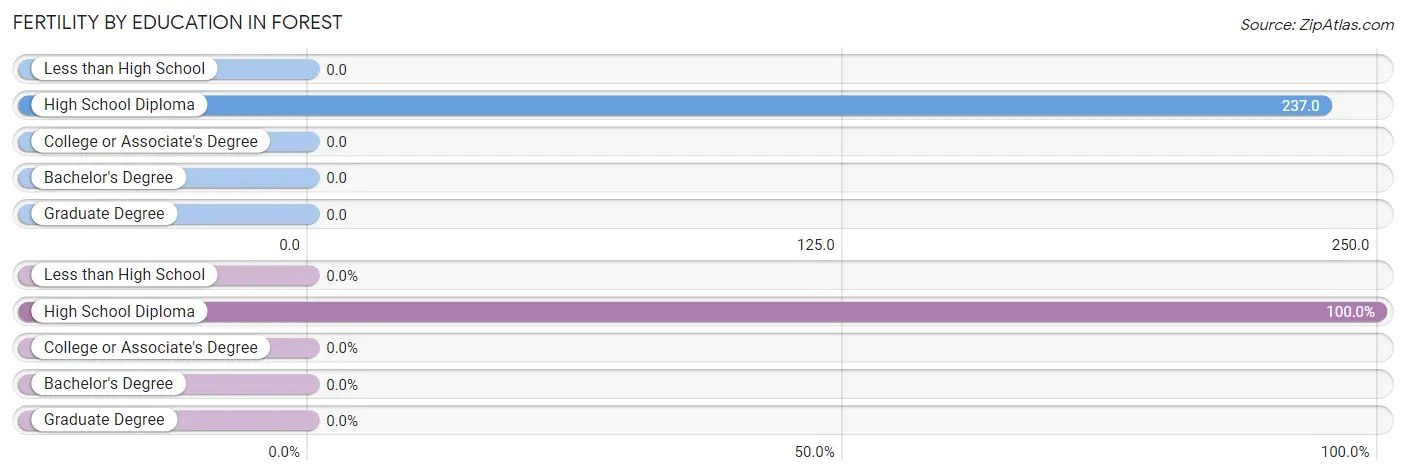
| Educational Attainment | Women with Births | Births / 1,000 Women |
| Less than High School | 0 (0.0%) | 0.0 |
| High School Diploma | 32 (100.0%) | 237.0 |
| College or Associate's Degree | 0 (0.0%) | 0.0 |
| Bachelor's Degree | 0 (0.0%) | 0.0 |
| Graduate Degree | 0 (0.0%) | 0.0 |
| Total | 32 (100.0%) | 93.0 |
Fertility by Education by Marriage Status in Forest

| Educational Attainment | Married | Unmarried |
| Less than High School | 0 (0.0%) | 0 (0.0%) |
| High School Diploma | 32 (100.0%) | 0 (0.0%) |
| College or Associate's Degree | 0 (0.0%) | 0 (0.0%) |
| Bachelor's Degree | 0 (0.0%) | 0 (0.0%) |
| Graduate Degree | 0 (0.0%) | 0 (0.0%) |
| Total | 32 (100.0%) | 0 (0.0%) |
Employment Characteristics in Forest
Employment by Class of Employer in Forest
Among the 784 employed individuals in Forest, private company employees (516 | 65.8%), local government employees (94 | 12.0%), and self-employed (not incorporated) (72 | 9.2%) make up the most common classes of employment.

| Employer Class | # Employees | % Employees |
| Private Company Employees | 516 | 65.8% |
| Self-Employed (Incorporated) | 4 | 0.5% |
| Self-Employed (Not Incorporated) | 72 | 9.2% |
| Not-for-profit Organizations | 57 | 7.3% |
| Local Government Employees | 94 | 12.0% |
| State Government Employees | 22 | 2.8% |
| Federal Government Employees | 19 | 2.4% |
| Unpaid Family Workers | 0 | 0.0% |
| Total | 784 | 100.0% |
Employment Status by Age in Forest
According to the labor force statistics for Forest, out of the total population over 16 years of age (1,111), 73.1% or 812 individuals are in the labor force, with 3.1% or 25 of them unemployed. The age group with the highest labor force participation rate is 25 to 29 years, with 93.1% or 135 individuals in the labor force. Within the labor force, the 16 to 19 years age range has the highest percentage of unemployed individuals, with 36.4% or 4 of them being unemployed.

| Age Bracket | In Labor Force | Unemployed |
| 16 to 19 Years | 11 (19.0%) | 4 (36.4%) |
| 20 to 24 Years | 82 (86.3%) | 0 (0.0%) |
| 25 to 29 Years | 135 (93.1%) | 12 (8.9%) |
| 30 to 34 Years | 38 (90.5%) | 0 (0.0%) |
| 35 to 44 Years | 192 (88.9%) | 4 (2.1%) |
| 45 to 54 Years | 139 (86.9%) | 5 (3.6%) |
| 55 to 59 Years | 89 (85.6%) | 0 (0.0%) |
| 60 to 64 Years | 87 (75.7%) | 0 (0.0%) |
| 65 to 74 Years | 34 (30.1%) | 0 (0.0%) |
| 75 Years and over | 5 (7.9%) | 0 (0.0%) |
| Total | 812 (73.1%) | 25 (3.1%) |
Employment Status by Educational Attainment in Forest
According to labor force statistics for Forest, 87.0% of individuals (680) out of the total population between 25 and 64 years of age (782) are in the labor force, with 3.1% or 21 of them being unemployed. The group with the highest labor force participation rate are those with the educational attainment of bachelor's degree or higher, with 92.1% or 93 individuals in the labor force. Within the labor force, individuals with less than high school education have the highest percentage of unemployment, with 6.8% or 3 of them being unemployed.

| Educational Attainment | In Labor Force | Unemployed |
| Less than High School | 44 (88.0%) | 3 (6.8%) |
| High School Diploma | 283 (81.8%) | 17 (4.9%) |
| College / Associate Degree | 260 (91.2%) | 4 (1.5%) |
| Bachelor's Degree or higher | 93 (92.1%) | 0 (0.0%) |
| Total | 680 (87.0%) | 24 (3.1%) |
Employment Occupations by Sex in Forest
Management, Business, Science and Arts Occupations
The most common Management, Business, Science and Arts occupations in Forest are Community & Social Service (73 | 9.3%), Management (70 | 8.9%), Education Instruction & Library (46 | 5.8%), Health Diagnosing & Treating (41 | 5.2%), and Business & Financial (35 | 4.4%).
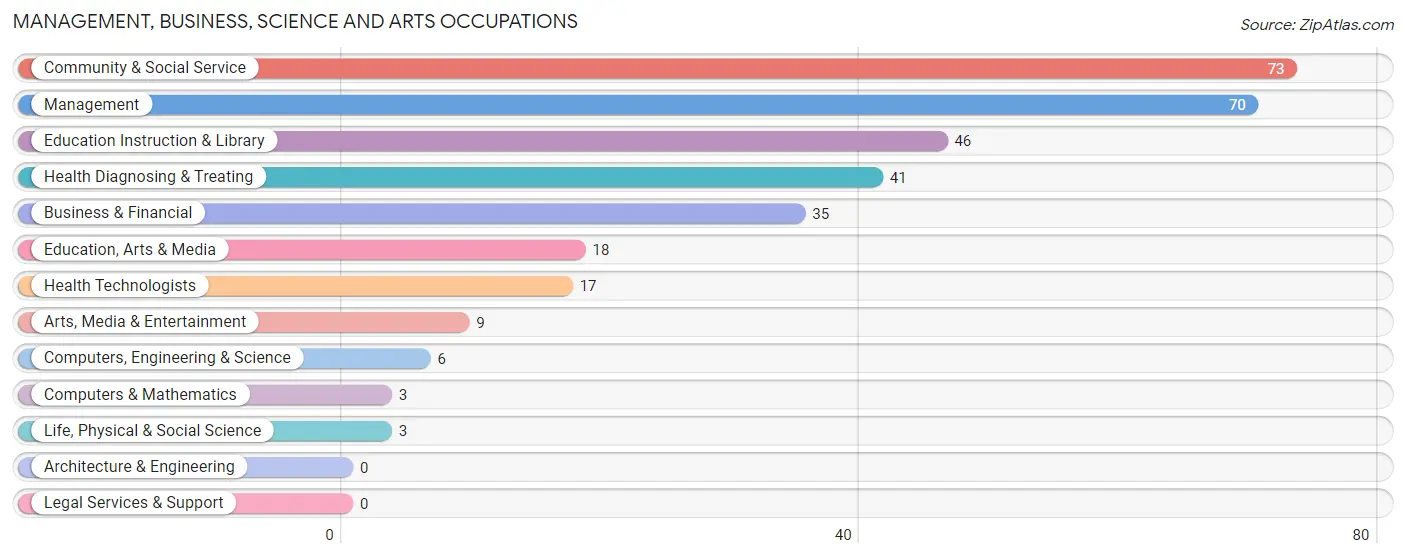
Management, Business, Science and Arts Occupations by Sex
Within the Management, Business, Science and Arts occupations in Forest, the most male-oriented occupations are Computers, Engineering & Science (100.0%), Computers & Mathematics (100.0%), and Life, Physical & Social Science (100.0%), while the most female-oriented occupations are Education, Arts & Media (100.0%), Health Diagnosing & Treating (100.0%), and Health Technologists (100.0%).
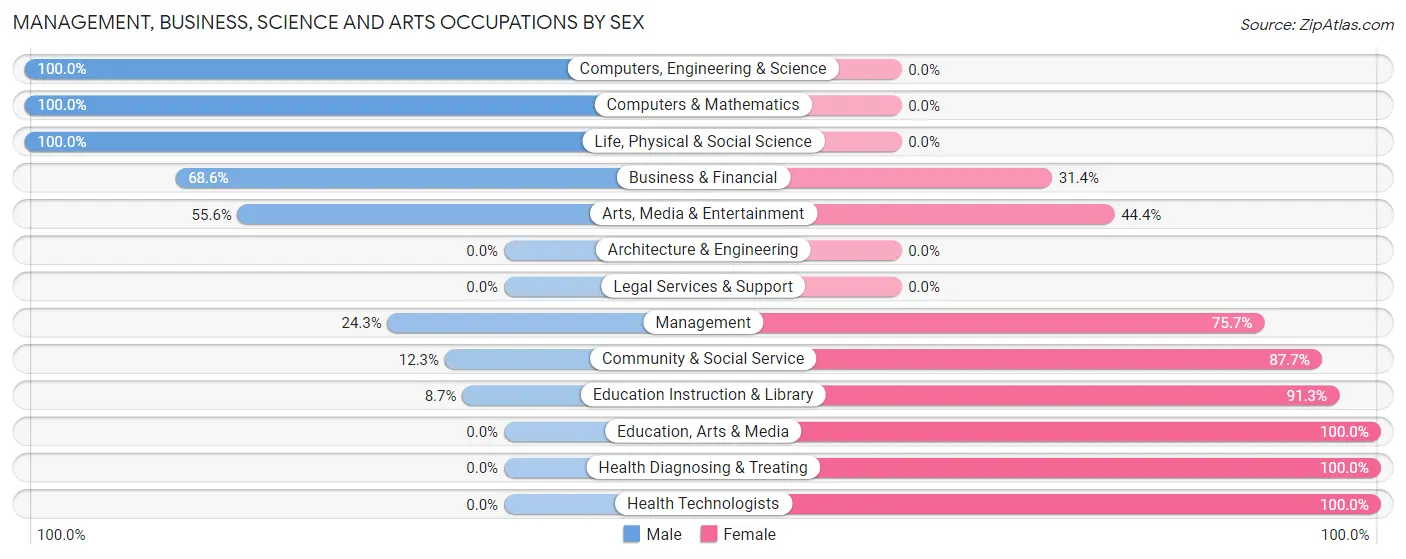
| Occupation | Male | Female |
| Management | 17 (24.3%) | 53 (75.7%) |
| Business & Financial | 24 (68.6%) | 11 (31.4%) |
| Computers, Engineering & Science | 6 (100.0%) | 0 (0.0%) |
| Computers & Mathematics | 3 (100.0%) | 0 (0.0%) |
| Architecture & Engineering | 0 (0.0%) | 0 (0.0%) |
| Life, Physical & Social Science | 3 (100.0%) | 0 (0.0%) |
| Community & Social Service | 9 (12.3%) | 64 (87.7%) |
| Education, Arts & Media | 0 (0.0%) | 18 (100.0%) |
| Legal Services & Support | 0 (0.0%) | 0 (0.0%) |
| Education Instruction & Library | 4 (8.7%) | 42 (91.3%) |
| Arts, Media & Entertainment | 5 (55.6%) | 4 (44.4%) |
| Health Diagnosing & Treating | 0 (0.0%) | 41 (100.0%) |
| Health Technologists | 0 (0.0%) | 17 (100.0%) |
| Total (Category) | 56 (24.9%) | 169 (75.1%) |
| Total (Overall) | 378 (48.0%) | 409 (52.0%) |
Services Occupations
The most common Services occupations in Forest are Food Preparation & Serving (49 | 6.2%), Healthcare Support (38 | 4.8%), Cleaning & Maintenance (22 | 2.8%), Personal Care & Service (20 | 2.5%), and Security & Protection (3 | 0.4%).

Services Occupations by Sex
Within the Services occupations in Forest, the most male-oriented occupations are Security & Protection (100.0%), Firefighting & Prevention (100.0%), and Food Preparation & Serving (81.6%), while the most female-oriented occupations are Personal Care & Service (100.0%), Healthcare Support (86.8%), and Cleaning & Maintenance (45.5%).

| Occupation | Male | Female |
| Healthcare Support | 5 (13.2%) | 33 (86.8%) |
| Security & Protection | 3 (100.0%) | 0 (0.0%) |
| Firefighting & Prevention | 3 (100.0%) | 0 (0.0%) |
| Law Enforcement | 0 (0.0%) | 0 (0.0%) |
| Food Preparation & Serving | 40 (81.6%) | 9 (18.4%) |
| Cleaning & Maintenance | 12 (54.5%) | 10 (45.5%) |
| Personal Care & Service | 0 (0.0%) | 20 (100.0%) |
| Total (Category) | 60 (45.5%) | 72 (54.5%) |
| Total (Overall) | 378 (48.0%) | 409 (52.0%) |
Sales and Office Occupations
The most common Sales and Office occupations in Forest are Office & Administration (106 | 13.5%), and Sales & Related (28 | 3.6%).

Sales and Office Occupations by Sex

| Occupation | Male | Female |
| Sales & Related | 8 (28.6%) | 20 (71.4%) |
| Office & Administration | 22 (20.7%) | 84 (79.2%) |
| Total (Category) | 30 (22.4%) | 104 (77.6%) |
| Total (Overall) | 378 (48.0%) | 409 (52.0%) |
Natural Resources, Construction and Maintenance Occupations
The most common Natural Resources, Construction and Maintenance occupations in Forest are Installation, Maintenance & Repair (73 | 9.3%), Farming, Fishing & Forestry (13 | 1.7%), and Construction & Extraction (12 | 1.5%).

Natural Resources, Construction and Maintenance Occupations by Sex

| Occupation | Male | Female |
| Farming, Fishing & Forestry | 13 (100.0%) | 0 (0.0%) |
| Construction & Extraction | 12 (100.0%) | 0 (0.0%) |
| Installation, Maintenance & Repair | 73 (100.0%) | 0 (0.0%) |
| Total (Category) | 98 (100.0%) | 0 (0.0%) |
| Total (Overall) | 378 (48.0%) | 409 (52.0%) |
Production, Transportation and Moving Occupations
The most common Production, Transportation and Moving occupations in Forest are Production (135 | 17.2%), Material Moving (42 | 5.3%), and Transportation (21 | 2.7%).

Production, Transportation and Moving Occupations by Sex

| Occupation | Male | Female |
| Production | 95 (70.4%) | 40 (29.6%) |
| Transportation | 7 (33.3%) | 14 (66.7%) |
| Material Moving | 32 (76.2%) | 10 (23.8%) |
| Total (Category) | 134 (67.7%) | 64 (32.3%) |
| Total (Overall) | 378 (48.0%) | 409 (52.0%) |
Employment Industries by Sex in Forest
Employment Industries in Forest
The major employment industries in Forest include Manufacturing (213 | 27.1%), Health Care & Social Assistance (101 | 12.8%), Educational Services (90 | 11.4%), Accommodation & Food Services (84 | 10.7%), and Transportation & Warehousing (61 | 7.7%).
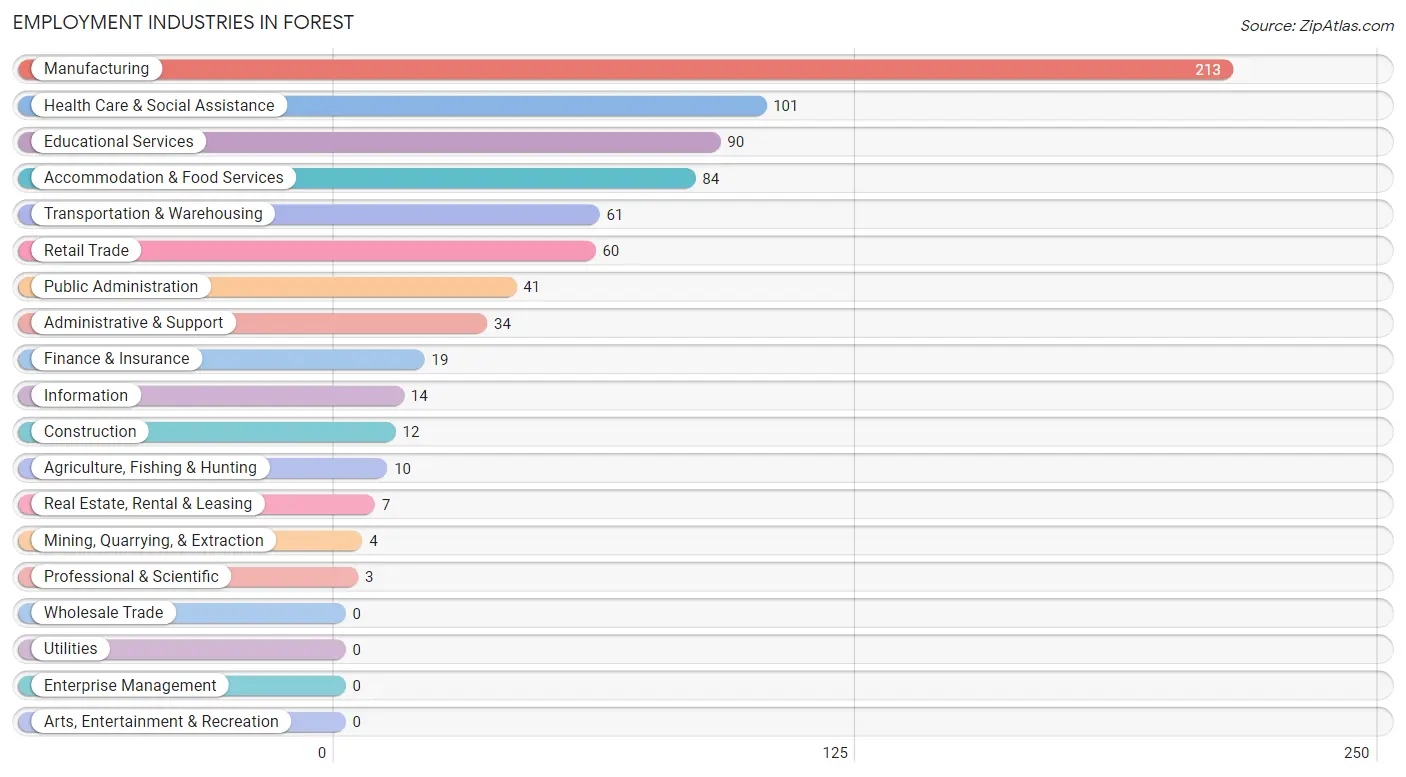
Employment Industries by Sex in Forest
The Forest industries that see more men than women are Agriculture, Fishing & Hunting (100.0%), Construction (100.0%), and Real Estate, Rental & Leasing (100.0%), whereas the industries that tend to have a higher number of women are Mining, Quarrying, & Extraction (100.0%), Finance & Insurance (100.0%), and Health Care & Social Assistance (95.1%).
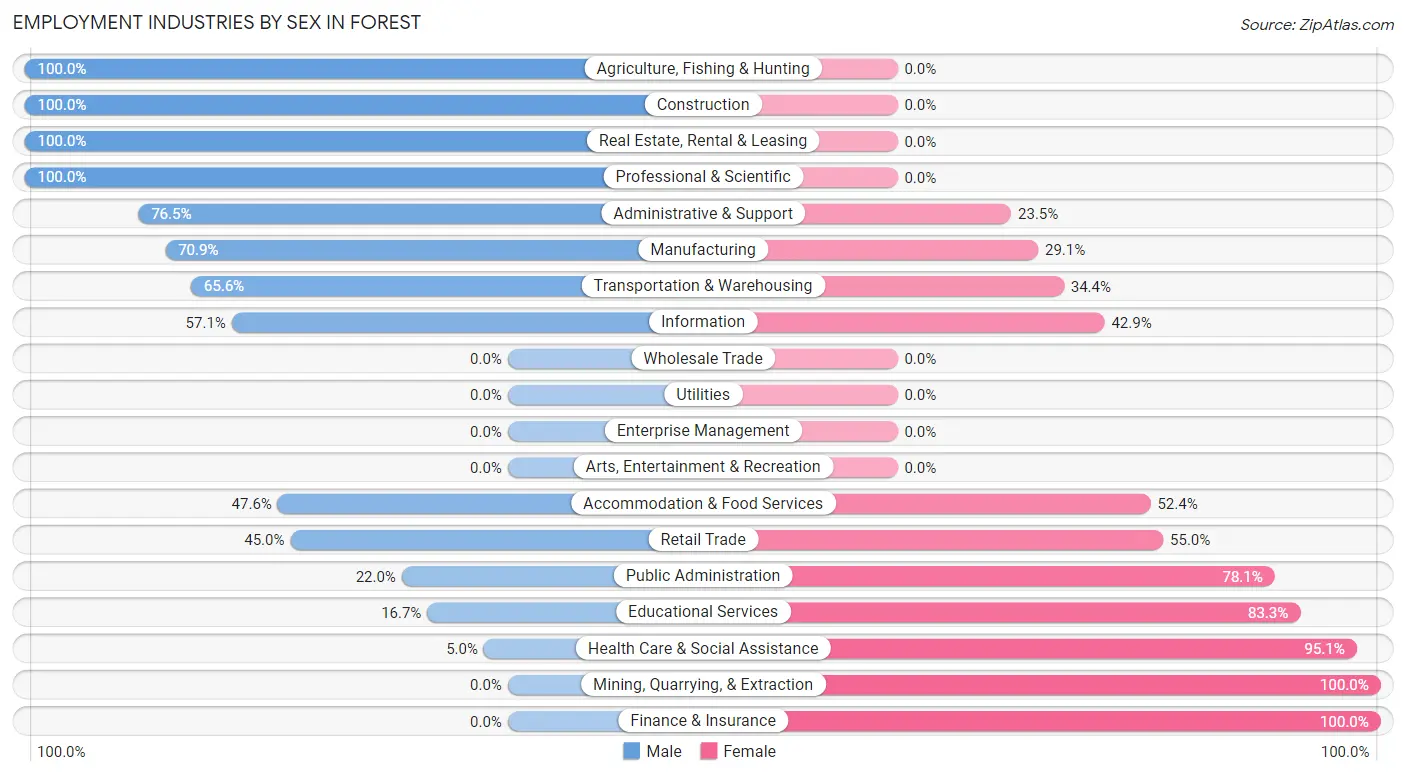
| Industry | Male | Female |
| Agriculture, Fishing & Hunting | 10 (100.0%) | 0 (0.0%) |
| Mining, Quarrying, & Extraction | 0 (0.0%) | 4 (100.0%) |
| Construction | 12 (100.0%) | 0 (0.0%) |
| Manufacturing | 151 (70.9%) | 62 (29.1%) |
| Wholesale Trade | 0 (0.0%) | 0 (0.0%) |
| Retail Trade | 27 (45.0%) | 33 (55.0%) |
| Transportation & Warehousing | 40 (65.6%) | 21 (34.4%) |
| Utilities | 0 (0.0%) | 0 (0.0%) |
| Information | 8 (57.1%) | 6 (42.9%) |
| Finance & Insurance | 0 (0.0%) | 19 (100.0%) |
| Real Estate, Rental & Leasing | 7 (100.0%) | 0 (0.0%) |
| Professional & Scientific | 3 (100.0%) | 0 (0.0%) |
| Enterprise Management | 0 (0.0%) | 0 (0.0%) |
| Administrative & Support | 26 (76.5%) | 8 (23.5%) |
| Educational Services | 15 (16.7%) | 75 (83.3%) |
| Health Care & Social Assistance | 5 (5.0%) | 96 (95.1%) |
| Arts, Entertainment & Recreation | 0 (0.0%) | 0 (0.0%) |
| Accommodation & Food Services | 40 (47.6%) | 44 (52.4%) |
| Public Administration | 9 (22.0%) | 32 (78.0%) |
| Total | 378 (48.0%) | 409 (52.0%) |
Education in Forest
School Enrollment in Forest
The most common levels of schooling among the 394 students in Forest are elementary school (104 | 26.4%), high school (98 | 24.9%), and middle school (76 | 19.3%).

| School Level | # Students | % Students |
| Nursery / Preschool | 11 | 2.8% |
| Kindergarten | 38 | 9.6% |
| Elementary School | 104 | 26.4% |
| Middle School | 76 | 19.3% |
| High School | 98 | 24.9% |
| College / Undergraduate | 49 | 12.4% |
| Graduate / Professional | 18 | 4.6% |
| Total | 394 | 100.0% |
School Enrollment by Age by Funding Source in Forest
Out of a total of 394 students who are enrolled in schools in Forest, 14 (3.6%) attend a private institution, while the remaining 380 (96.4%) are enrolled in public schools. The age group of 25 to 34 year olds has the highest likelihood of being enrolled in private schools, with 3 (9.1% in the age bracket) enrolled. Conversely, the age group of 3 to 4 year olds has the lowest likelihood of being enrolled in a private school, with 5 (100.0% in the age bracket) attending a public institution.

| Age Bracket | Public School | Private School |
| 3 to 4 Year Olds | 5 (100.0%) | 0 (0.0%) |
| 5 to 9 Year Old | 101 (95.3%) | 5 (4.7%) |
| 10 to 14 Year Olds | 131 (98.5%) | 2 (1.5%) |
| 15 to 17 Year Olds | 63 (94.0%) | 4 (6.0%) |
| 18 to 19 Year Olds | 16 (100.0%) | 0 (0.0%) |
| 20 to 24 Year Olds | 22 (100.0%) | 0 (0.0%) |
| 25 to 34 Year Olds | 30 (90.9%) | 3 (9.1%) |
| 35 Years and over | 12 (100.0%) | 0 (0.0%) |
| Total | 380 (96.4%) | 14 (3.6%) |
Educational Attainment by Field of Study in Forest
Arts & humanities (25 | 22.9%), education (19 | 17.4%), communications (15 | 13.8%), business (14 | 12.8%), and bio, nature & agricultural (10 | 9.2%) are the most common fields of study among 109 individuals in Forest who have obtained a bachelor's degree or higher.
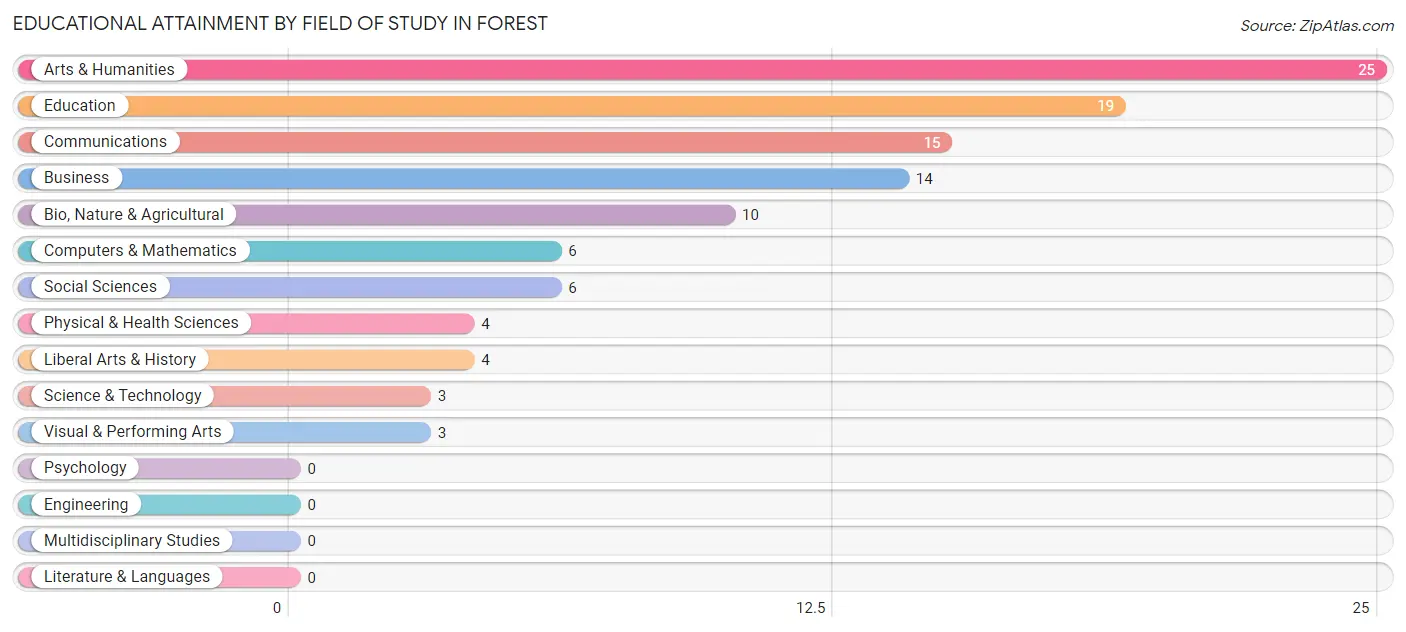
| Field of Study | # Graduates | % Graduates |
| Computers & Mathematics | 6 | 5.5% |
| Bio, Nature & Agricultural | 10 | 9.2% |
| Physical & Health Sciences | 4 | 3.7% |
| Psychology | 0 | 0.0% |
| Social Sciences | 6 | 5.5% |
| Engineering | 0 | 0.0% |
| Multidisciplinary Studies | 0 | 0.0% |
| Science & Technology | 3 | 2.8% |
| Business | 14 | 12.8% |
| Education | 19 | 17.4% |
| Literature & Languages | 0 | 0.0% |
| Liberal Arts & History | 4 | 3.7% |
| Visual & Performing Arts | 3 | 2.8% |
| Communications | 15 | 13.8% |
| Arts & Humanities | 25 | 22.9% |
| Total | 109 | 100.0% |
Transportation & Commute in Forest
Vehicle Availability by Sex in Forest
The most prevalent vehicle ownership categories in Forest are males with 2 vehicles (153, accounting for 40.5%) and females with 2 vehicles (120, making up 37.7%).

| Vehicles Available | Male | Female |
| No Vehicle | 4 (1.1%) | 3 (0.7%) |
| 1 Vehicle | 100 (26.5%) | 144 (35.5%) |
| 2 Vehicles | 153 (40.5%) | 120 (29.6%) |
| 3 Vehicles | 82 (21.7%) | 76 (18.7%) |
| 4 Vehicles | 16 (4.2%) | 9 (2.2%) |
| 5 or more Vehicles | 23 (6.1%) | 54 (13.3%) |
| Total | 378 (100.0%) | 406 (100.0%) |
Commute Time in Forest
The most frequently occuring commute durations in Forest are 5 to 9 minutes (130 commuters, 16.9%), 20 to 24 minutes (95 commuters, 12.3%), and 15 to 19 minutes (87 commuters, 11.3%).
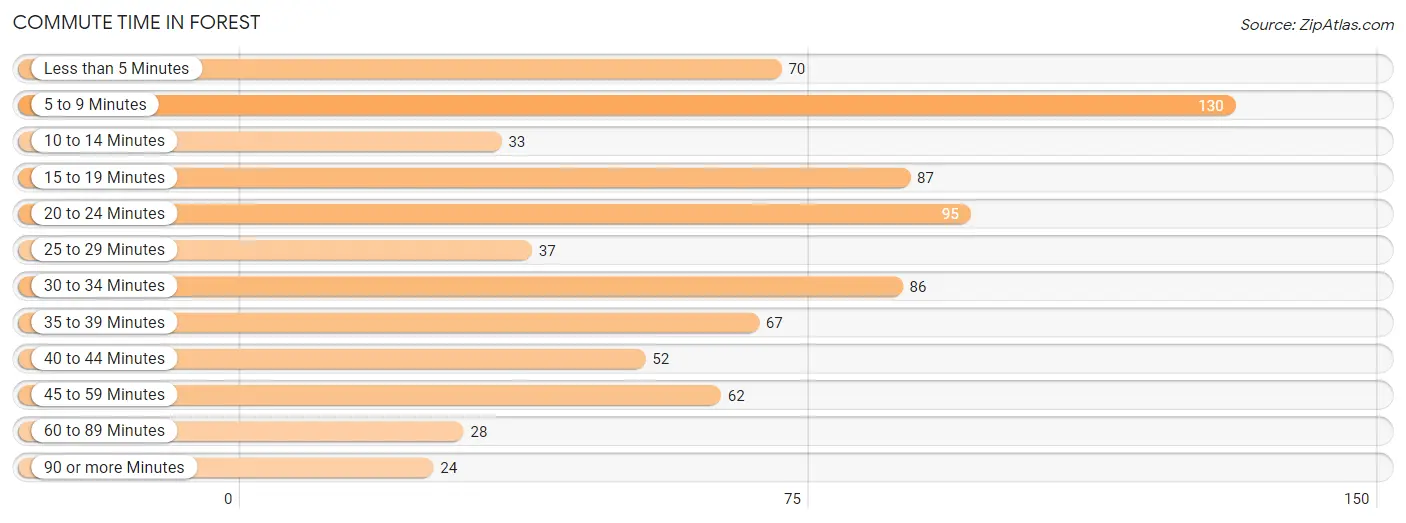
| Commute Time | # Commuters | % Commuters |
| Less than 5 Minutes | 70 | 9.1% |
| 5 to 9 Minutes | 130 | 16.9% |
| 10 to 14 Minutes | 33 | 4.3% |
| 15 to 19 Minutes | 87 | 11.3% |
| 20 to 24 Minutes | 95 | 12.3% |
| 25 to 29 Minutes | 37 | 4.8% |
| 30 to 34 Minutes | 86 | 11.2% |
| 35 to 39 Minutes | 67 | 8.7% |
| 40 to 44 Minutes | 52 | 6.7% |
| 45 to 59 Minutes | 62 | 8.0% |
| 60 to 89 Minutes | 28 | 3.6% |
| 90 or more Minutes | 24 | 3.1% |
Commute Time by Sex in Forest
The most common commute times in Forest are 5 to 9 minutes (61 commuters, 16.3%) for males and 5 to 9 minutes (69 commuters, 17.4%) for females.
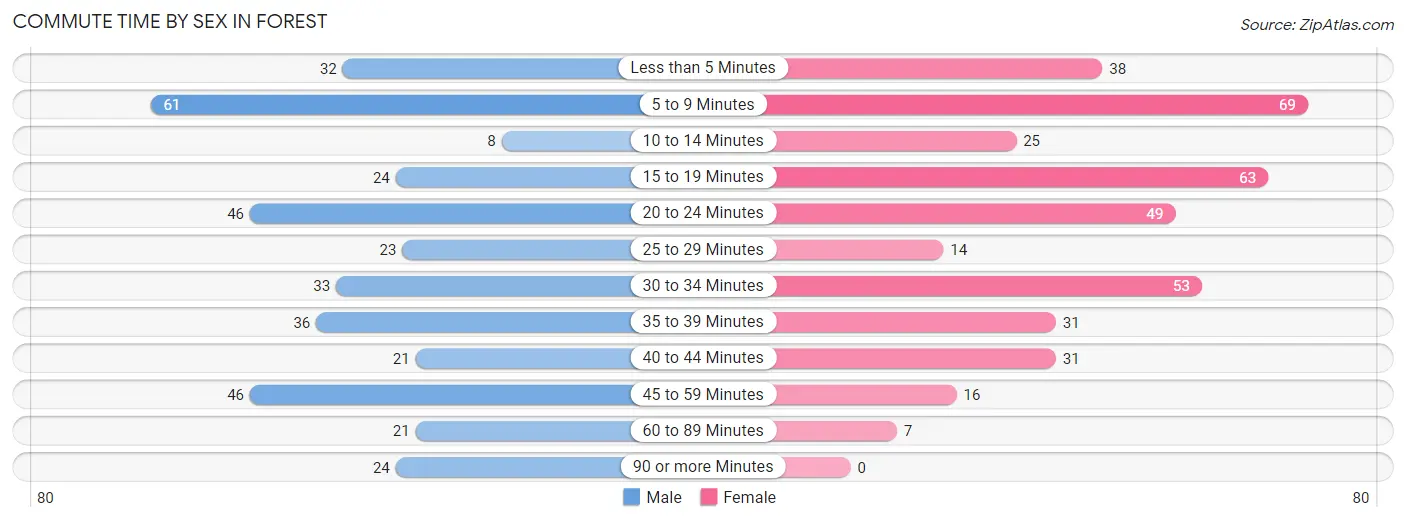
| Commute Time | Male | Female |
| Less than 5 Minutes | 32 (8.5%) | 38 (9.6%) |
| 5 to 9 Minutes | 61 (16.3%) | 69 (17.4%) |
| 10 to 14 Minutes | 8 (2.1%) | 25 (6.3%) |
| 15 to 19 Minutes | 24 (6.4%) | 63 (15.9%) |
| 20 to 24 Minutes | 46 (12.3%) | 49 (12.4%) |
| 25 to 29 Minutes | 23 (6.1%) | 14 (3.5%) |
| 30 to 34 Minutes | 33 (8.8%) | 53 (13.4%) |
| 35 to 39 Minutes | 36 (9.6%) | 31 (7.8%) |
| 40 to 44 Minutes | 21 (5.6%) | 31 (7.8%) |
| 45 to 59 Minutes | 46 (12.3%) | 16 (4.0%) |
| 60 to 89 Minutes | 21 (5.6%) | 7 (1.8%) |
| 90 or more Minutes | 24 (6.4%) | 0 (0.0%) |
Time of Departure to Work by Sex in Forest
The most frequent times of departure to work in Forest are 12:00 PM to 3:59 PM (62, 16.5%) for males and 7:00 AM to 7:29 AM (149, 37.6%) for females.
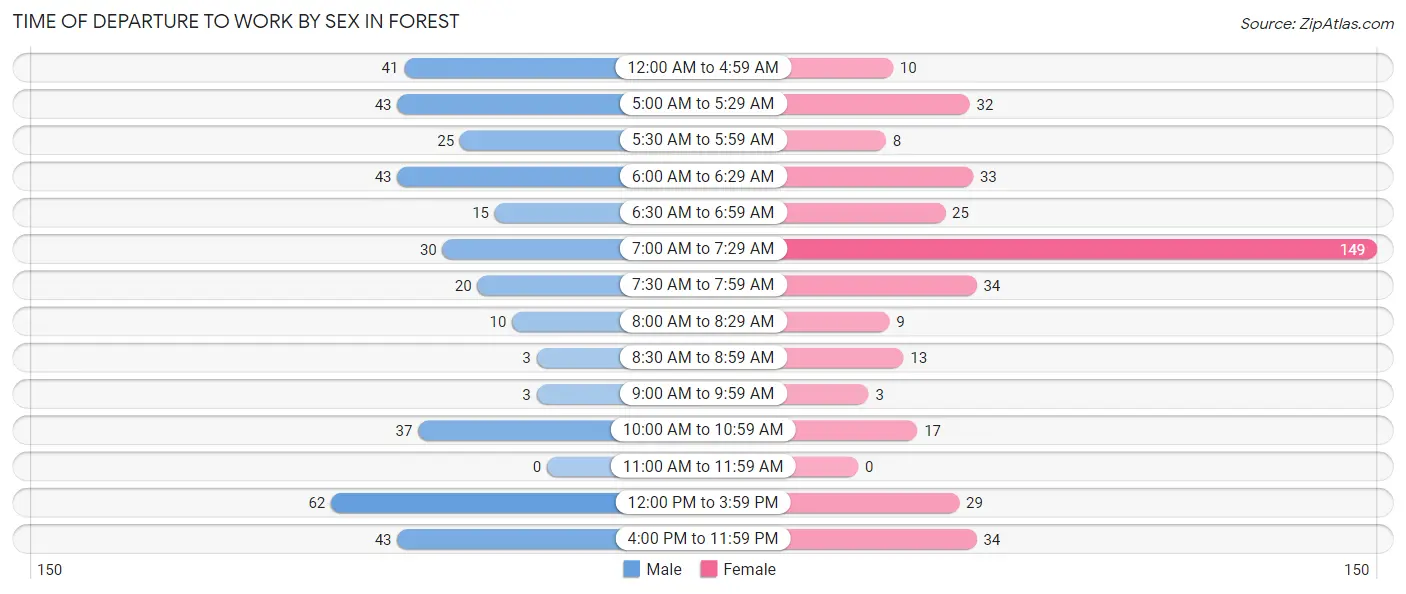
| Time of Departure | Male | Female |
| 12:00 AM to 4:59 AM | 41 (10.9%) | 10 (2.5%) |
| 5:00 AM to 5:29 AM | 43 (11.5%) | 32 (8.1%) |
| 5:30 AM to 5:59 AM | 25 (6.7%) | 8 (2.0%) |
| 6:00 AM to 6:29 AM | 43 (11.5%) | 33 (8.3%) |
| 6:30 AM to 6:59 AM | 15 (4.0%) | 25 (6.3%) |
| 7:00 AM to 7:29 AM | 30 (8.0%) | 149 (37.6%) |
| 7:30 AM to 7:59 AM | 20 (5.3%) | 34 (8.6%) |
| 8:00 AM to 8:29 AM | 10 (2.7%) | 9 (2.3%) |
| 8:30 AM to 8:59 AM | 3 (0.8%) | 13 (3.3%) |
| 9:00 AM to 9:59 AM | 3 (0.8%) | 3 (0.8%) |
| 10:00 AM to 10:59 AM | 37 (9.9%) | 17 (4.3%) |
| 11:00 AM to 11:59 AM | 0 (0.0%) | 0 (0.0%) |
| 12:00 PM to 3:59 PM | 62 (16.5%) | 29 (7.3%) |
| 4:00 PM to 11:59 PM | 43 (11.5%) | 34 (8.6%) |
| Total | 375 (100.0%) | 396 (100.0%) |
Housing Occupancy in Forest
Occupancy by Ownership in Forest
Of the total 602 dwellings in Forest, owner-occupied units account for 439 (72.9%), while renter-occupied units make up 163 (27.1%).

| Occupancy | # Housing Units | % Housing Units |
| Owner Occupied Housing Units | 439 | 72.9% |
| Renter-Occupied Housing Units | 163 | 27.1% |
| Total Occupied Housing Units | 602 | 100.0% |
Occupancy by Household Size in Forest

| Household Size | # Housing Units | % Housing Units |
| 1-Person Household | 157 | 26.1% |
| 2-Person Household | 225 | 37.4% |
| 3-Person Household | 53 | 8.8% |
| 4+ Person Household | 167 | 27.7% |
| Total Housing Units | 602 | 100.0% |
Occupancy by Ownership by Household Size in Forest

| Household Size | Owner-occupied | Renter-occupied |
| 1-Person Household | 102 (65.0%) | 55 (35.0%) |
| 2-Person Household | 186 (82.7%) | 39 (17.3%) |
| 3-Person Household | 25 (47.2%) | 28 (52.8%) |
| 4+ Person Household | 126 (75.4%) | 41 (24.5%) |
| Total Housing Units | 439 (72.9%) | 163 (27.1%) |
Occupancy by Educational Attainment in Forest

| Household Size | Owner-occupied | Renter-occupied |
| Less than High School | 26 (72.2%) | 10 (27.8%) |
| High School Diploma | 194 (68.3%) | 90 (31.7%) |
| College/Associate Degree | 174 (78.0%) | 49 (22.0%) |
| Bachelor's Degree or higher | 45 (76.3%) | 14 (23.7%) |
Occupancy by Age of Householder in Forest

| Age Bracket | # Households | % Households |
| Under 35 Years | 115 | 19.1% |
| 35 to 44 Years | 135 | 22.4% |
| 45 to 54 Years | 112 | 18.6% |
| 55 to 64 Years | 120 | 19.9% |
| 65 to 74 Years | 80 | 13.3% |
| 75 to 84 Years | 37 | 6.1% |
| 85 Years and Over | 3 | 0.5% |
| Total | 602 | 100.0% |
Housing Finances in Forest
Median Income by Occupancy in Forest

| Occupancy Type | # Households | Median Income |
| Owner-Occupied | 439 (72.9%) | $57,159 |
| Renter-Occupied | 163 (27.1%) | $40,509 |
| Average | 602 (100.0%) | $46,731 |
Occupancy by Householder Income Bracket in Forest
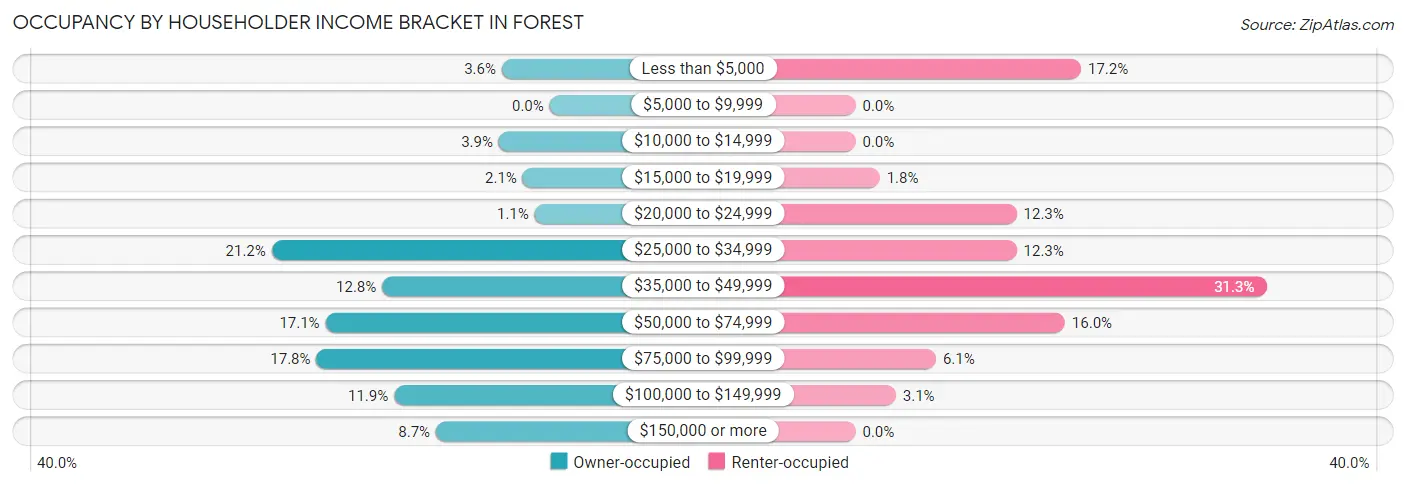
| Income Bracket | Owner-occupied | Renter-occupied |
| Less than $5,000 | 16 (3.6%) | 28 (17.2%) |
| $5,000 to $9,999 | 0 (0.0%) | 0 (0.0%) |
| $10,000 to $14,999 | 17 (3.9%) | 0 (0.0%) |
| $15,000 to $19,999 | 9 (2.1%) | 3 (1.8%) |
| $20,000 to $24,999 | 5 (1.1%) | 20 (12.3%) |
| $25,000 to $34,999 | 93 (21.2%) | 20 (12.3%) |
| $35,000 to $49,999 | 56 (12.8%) | 51 (31.3%) |
| $50,000 to $74,999 | 75 (17.1%) | 26 (16.0%) |
| $75,000 to $99,999 | 78 (17.8%) | 10 (6.1%) |
| $100,000 to $149,999 | 52 (11.8%) | 5 (3.1%) |
| $150,000 or more | 38 (8.7%) | 0 (0.0%) |
| Total | 439 (100.0%) | 163 (100.0%) |
Monthly Housing Cost Tiers in Forest

| Monthly Cost | Owner-occupied | Renter-occupied |
| Less than $300 | 22 (5.0%) | 0 (0.0%) |
| $300 to $499 | 126 (28.7%) | 0 (0.0%) |
| $500 to $799 | 77 (17.5%) | 95 (58.3%) |
| $800 to $999 | 72 (16.4%) | 42 (25.8%) |
| $1,000 to $1,499 | 101 (23.0%) | 5 (3.1%) |
| $1,500 to $1,999 | 41 (9.3%) | 0 (0.0%) |
| $2,000 to $2,499 | 0 (0.0%) | 0 (0.0%) |
| $2,500 to $2,999 | 0 (0.0%) | 0 (0.0%) |
| $3,000 or more | 0 (0.0%) | 0 (0.0%) |
| Total | 439 (100.0%) | 163 (100.0%) |
Physical Housing Characteristics in Forest
Housing Structures in Forest

| Structure Type | # Housing Units | % Housing Units |
| Single Unit, Detached | 516 | 85.7% |
| Single Unit, Attached | 3 | 0.5% |
| 2 Unit Apartments | 0 | 0.0% |
| 3 or 4 Unit Apartments | 16 | 2.7% |
| 5 to 9 Unit Apartments | 11 | 1.8% |
| 10 or more Apartments | 0 | 0.0% |
| Mobile Home / Other | 56 | 9.3% |
| Total | 602 | 100.0% |
Housing Structures by Occupancy in Forest

| Structure Type | Owner-occupied | Renter-occupied |
| Single Unit, Detached | 427 (82.8%) | 89 (17.2%) |
| Single Unit, Attached | 0 (0.0%) | 3 (100.0%) |
| 2 Unit Apartments | 0 (0.0%) | 0 (0.0%) |
| 3 or 4 Unit Apartments | 0 (0.0%) | 16 (100.0%) |
| 5 to 9 Unit Apartments | 0 (0.0%) | 11 (100.0%) |
| 10 or more Apartments | 0 (0.0%) | 0 (0.0%) |
| Mobile Home / Other | 12 (21.4%) | 44 (78.6%) |
| Total | 439 (72.9%) | 163 (27.1%) |
Housing Structures by Number of Rooms in Forest

| Number of Rooms | Owner-occupied | Renter-occupied |
| 1 Room | 0 (0.0%) | 0 (0.0%) |
| 2 or 3 Rooms | 0 (0.0%) | 20 (12.3%) |
| 4 or 5 Rooms | 42 (9.6%) | 95 (58.3%) |
| 6 or 7 Rooms | 274 (62.4%) | 39 (23.9%) |
| 8 or more Rooms | 123 (28.0%) | 9 (5.5%) |
| Total | 439 (100.0%) | 163 (100.0%) |
Housing Structure by Heating Type in Forest

| Heating Type | Owner-occupied | Renter-occupied |
| Utility Gas | 361 (82.2%) | 82 (50.3%) |
| Bottled, Tank, or LP Gas | 2 (0.5%) | 9 (5.5%) |
| Electricity | 65 (14.8%) | 65 (39.9%) |
| Fuel Oil or Kerosene | 3 (0.7%) | 0 (0.0%) |
| Coal or Coke | 0 (0.0%) | 0 (0.0%) |
| All other Fuels | 8 (1.8%) | 7 (4.3%) |
| No Fuel Used | 0 (0.0%) | 0 (0.0%) |
| Total | 439 (100.0%) | 163 (100.0%) |
Household Vehicle Usage in Forest

| Vehicles per Household | Owner-occupied | Renter-occupied |
| No Vehicle | 5 (1.1%) | 1 (0.6%) |
| 1 Vehicle | 162 (36.9%) | 91 (55.8%) |
| 2 Vehicles | 161 (36.7%) | 44 (27.0%) |
| 3 or more Vehicles | 111 (25.3%) | 27 (16.6%) |
| Total | 439 (100.0%) | 163 (100.0%) |
Real Estate & Mortgages in Forest
Real Estate and Mortgage Overview in Forest
| Characteristic | Without Mortgage | With Mortgage |
| Housing Units | 199 | 240 |
| Median Property Value | $78,800 | $123,000 |
| Median Household Income | $42,188 | $38 |
| Monthly Housing Costs | $450 | $0 |
| Real Estate Taxes | $780 | $0 |
Property Value by Mortgage Status in Forest

| Property Value | Without Mortgage | With Mortgage |
| Less than $50,000 | 28 (14.1%) | 7 (2.9%) |
| $50,000 to $99,999 | 107 (53.8%) | 68 (28.3%) |
| $100,000 to $299,999 | 61 (30.6%) | 165 (68.8%) |
| $300,000 to $499,999 | 3 (1.5%) | 0 (0.0%) |
| $500,000 to $749,999 | 0 (0.0%) | 0 (0.0%) |
| $750,000 to $999,999 | 0 (0.0%) | 0 (0.0%) |
| $1,000,000 or more | 0 (0.0%) | 0 (0.0%) |
| Total | 199 (100.0%) | 240 (100.0%) |
Household Income by Mortgage Status in Forest

| Household Income | Without Mortgage | With Mortgage |
| Less than $10,000 | 16 (8.0%) | 7 (2.9%) |
| $10,000 to $24,999 | 11 (5.5%) | 0 (0.0%) |
| $25,000 to $34,999 | 56 (28.1%) | 20 (8.3%) |
| $35,000 to $49,999 | 33 (16.6%) | 37 (15.4%) |
| $50,000 to $74,999 | 38 (19.1%) | 23 (9.6%) |
| $75,000 to $99,999 | 23 (11.6%) | 37 (15.4%) |
| $100,000 to $149,999 | 22 (11.1%) | 55 (22.9%) |
| $150,000 or more | 0 (0.0%) | 30 (12.5%) |
| Total | 199 (100.0%) | 240 (100.0%) |
Property Value to Household Income Ratio in Forest

| Value-to-Income Ratio | Without Mortgage | With Mortgage |
| Less than 2.0x | 83 (41.7%) | 80,000 (33,333.3%) |
| 2.0x to 2.9x | 36 (18.1%) | 144 (60.0%) |
| 3.0x to 3.9x | 53 (26.6%) | 47 (19.6%) |
| 4.0x or more | 19 (9.6%) | 21 (8.7%) |
| Total | 199 (100.0%) | 240 (100.0%) |
Real Estate Taxes by Mortgage Status in Forest

| Property Taxes | Without Mortgage | With Mortgage |
| Less than $800 | 103 (51.8%) | 0 (0.0%) |
| $800 to $1,499 | 67 (33.7%) | 43 (17.9%) |
| $800 to $1,499 | 21 (10.5%) | 110 (45.8%) |
| Total | 199 (100.0%) | 240 (100.0%) |
Health & Disability in Forest
Health Insurance Coverage by Age in Forest

| Age Bracket | With Coverage | Without Coverage |
| Under 6 Years | 83 (100.0%) | 0 (0.0%) |
| 6 to 18 Years | 300 (95.2%) | 15 (4.8%) |
| 19 to 25 Years | 88 (82.2%) | 19 (17.8%) |
| 26 to 34 Years | 166 (92.7%) | 13 (7.3%) |
| 35 to 44 Years | 199 (92.1%) | 17 (7.9%) |
| 45 to 54 Years | 140 (87.5%) | 20 (12.5%) |
| 55 to 64 Years | 114 (52.0%) | 105 (47.9%) |
| 65 to 74 Years | 113 (100.0%) | 0 (0.0%) |
| 75 Years and older | 63 (100.0%) | 0 (0.0%) |
| Total | 1,266 (87.0%) | 189 (13.0%) |
Health Insurance Coverage by Citizenship Status in Forest

| Citizenship Status | With Coverage | Without Coverage |
| Native Born | 83 (100.0%) | 0 (0.0%) |
| Foreign Born, Citizen | 300 (95.2%) | 15 (4.8%) |
| Foreign Born, not a Citizen | 88 (82.2%) | 19 (17.8%) |
Health Insurance Coverage by Household Income in Forest

| Household Income | With Coverage | Without Coverage |
| Under $25,000 | 157 (81.8%) | 35 (18.2%) |
| $25,000 to $49,999 | 346 (76.9%) | 104 (23.1%) |
| $50,000 to $74,999 | 192 (98.5%) | 3 (1.5%) |
| $75,000 to $99,999 | 228 (82.9%) | 47 (17.1%) |
| $100,000 and over | 343 (100.0%) | 0 (0.0%) |
Public vs Private Health Insurance Coverage by Age in Forest

| Age Bracket | Public Insurance | Private Insurance |
| Under 6 | 24 (28.9%) | 62 (74.7%) |
| 6 to 18 Years | 90 (28.6%) | 216 (68.6%) |
| 19 to 25 Years | 21 (19.6%) | 67 (62.6%) |
| 25 to 34 Years | 66 (36.9%) | 103 (57.5%) |
| 35 to 44 Years | 39 (18.1%) | 163 (75.5%) |
| 45 to 54 Years | 37 (23.1%) | 103 (64.4%) |
| 55 to 64 Years | 30 (13.7%) | 84 (38.4%) |
| 65 to 74 Years | 110 (97.4%) | 58 (51.3%) |
| 75 Years and over | 63 (100.0%) | 28 (44.4%) |
| Total | 480 (33.0%) | 884 (60.8%) |
Disability Status by Sex by Age in Forest

| Age Bracket | Male | Female |
| Under 5 Years | 0 (0.0%) | 0 (0.0%) |
| 5 to 17 Years | 10 (6.6%) | 3 (1.7%) |
| 18 to 34 Years | 6 (4.4%) | 19 (11.5%) |
| 35 to 64 Years | 31 (10.4%) | 48 (16.2%) |
| 65 to 74 Years | 7 (15.9%) | 12 (17.4%) |
| 75 Years and over | 20 (57.1%) | 3 (10.7%) |
Disability Class by Sex by Age in Forest
Disability Class: Hearing Difficulty

| Age Bracket | Male | Female |
| Under 5 Years | 0 (0.0%) | 0 (0.0%) |
| 5 to 17 Years | 4 (2.6%) | 0 (0.0%) |
| 18 to 34 Years | 0 (0.0%) | 12 (7.3%) |
| 35 to 64 Years | 22 (7.4%) | 5 (1.7%) |
| 65 to 74 Years | 4 (9.1%) | 6 (8.7%) |
| 75 Years and over | 15 (42.9%) | 3 (10.7%) |
Disability Class: Vision Difficulty

| Age Bracket | Male | Female |
| Under 5 Years | 0 (0.0%) | 0 (0.0%) |
| 5 to 17 Years | 0 (0.0%) | 0 (0.0%) |
| 18 to 34 Years | 0 (0.0%) | 3 (1.8%) |
| 35 to 64 Years | 0 (0.0%) | 4 (1.3%) |
| 65 to 74 Years | 0 (0.0%) | 3 (4.3%) |
| 75 Years and over | 0 (0.0%) | 0 (0.0%) |
Disability Class: Cognitive Difficulty

| Age Bracket | Male | Female |
| 5 to 17 Years | 6 (4.0%) | 3 (1.7%) |
| 18 to 34 Years | 6 (4.4%) | 4 (2.4%) |
| 35 to 64 Years | 0 (0.0%) | 18 (6.1%) |
| 65 to 74 Years | 0 (0.0%) | 2 (2.9%) |
| 75 Years and over | 2 (5.7%) | 0 (0.0%) |
Disability Class: Ambulatory Difficulty

| Age Bracket | Male | Female |
| 5 to 17 Years | 0 (0.0%) | 3 (1.7%) |
| 18 to 34 Years | 0 (0.0%) | 3 (1.8%) |
| 35 to 64 Years | 9 (3.0%) | 33 (11.2%) |
| 65 to 74 Years | 3 (6.8%) | 9 (13.0%) |
| 75 Years and over | 11 (31.4%) | 0 (0.0%) |
Disability Class: Self-Care Difficulty

| Age Bracket | Male | Female |
| 5 to 17 Years | 4 (2.6%) | 0 (0.0%) |
| 18 to 34 Years | 0 (0.0%) | 0 (0.0%) |
| 35 to 64 Years | 3 (1.0%) | 5 (1.7%) |
| 65 to 74 Years | 0 (0.0%) | 2 (2.9%) |
| 75 Years and over | 2 (5.7%) | 3 (10.7%) |
Technology Access in Forest
Computing Device Access in Forest

| Device Type | # Households | % Households |
| Desktop or Laptop | 489 | 81.2% |
| Smartphone | 521 | 86.5% |
| Tablet | 326 | 54.1% |
| No Computing Device | 42 | 7.0% |
| Total | 602 | 100.0% |
Internet Access in Forest

| Internet Type | # Households | % Households |
| Dial-Up Internet | 0 | 0.0% |
| Broadband Home | 422 | 70.1% |
| Cellular Data Only | 108 | 17.9% |
| Satellite Internet | 6 | 1.0% |
| No Internet | 61 | 10.1% |
| Total | 602 | 100.0% |
Forest Summary
Forest, Ohio is a small village located in the northwest corner of Hardin County, Ohio. It is situated on the banks of the Blanchard River, and is part of the Lima Metropolitan Statistical Area. The village has a population of 1,845 as of the 2010 census, and is the smallest village in Hardin County.
History
The area that is now Forest was first settled in 1835 by a group of settlers from Pennsylvania. The village was originally known as “The Forks”, due to its location at the confluence of the Blanchard and Auglaize Rivers. In 1845, the village was renamed Forest, after the nearby forest of hardwood trees.
The village was incorporated in 1854, and the first mayor was elected in 1855. The village grew slowly, and by the turn of the century, it had a population of just over 500.
In the early 1900s, the village was home to several industries, including a sawmill, a grist mill, a brickyard, and a furniture factory. The village also had a railroad station, which connected it to the rest of the state.
In the 1950s, the village began to experience a population decline, as many of its residents moved away in search of better job opportunities. By the 1970s, the population had dropped to just over 1,000.
Geography
Forest is located at 40°45'N, 83°45'W (40.75, -83.75). It is situated on the banks of the Blanchard River, and is part of the Lima Metropolitan Statistical Area. The village has a total area of 0.9 square miles, all of which is land.
The village is located in a rural area, and is surrounded by farmland. The nearest major city is Lima, which is located about 20 miles to the east.
Economy
The economy of Forest is largely based on agriculture. The village is home to several farms, which produce corn, soybeans, and wheat. The village also has a few small businesses, including a grocery store, a hardware store, and a restaurant.
Demographics
As of the 2010 census, there were 1,845 people, 717 households, and 486 families residing in the village. The population density was 2,039.2 people per square mile. The racial makeup of the village was 97.3% White, 0.3% African American, 0.2% Native American, 0.2% Asian, 0.1% Pacific Islander, 0.7% from other races, and 1.2% from two or more races. Hispanic or Latino of any race were 1.7% of the population.
There were 717 households, out of which 33.2% had children under the age of 18 living with them, 48.2% were married couples living together, 13.2% had a female householder with no husband present, and 33.2% were non-families. 28.7% of all households were made up of individuals, and 13.2% had someone living alone who was 65 years of age or older. The average household size was 2.56 and the average family size was 3.14.
In the village, the population was spread out, with 27.2% under the age of 18, 8.2% from 18 to 24, 28.2% from 25 to 44, 22.2% from 45 to 64, and 14.2% who were 65 years of age or older. The median age was 36 years. For every 100 females, there were 95.2 males. For every 100 females age 18 and over, there were 91.2 males.
The median income for a household in the village was $35,000, and the median income for a family was $41,250. Males had a median income of $30,000 versus $21,250 for females. The per capita income for the village was $16,845. About 8.2% of families and 11.2% of the population were below the poverty line, including 14.2% of those under age 18 and 8.2% of those age 65 or over.
Common Questions
What is Per Capita Income in Forest?
Per Capita income in Forest is $24,740.
What is the Median Family Income in Forest?
Median Family Income in Forest is $53,750.
What is the Median Household income in Forest?
Median Household Income in Forest is $46,731.
What is Income or Wage Gap in Forest?
Income or Wage Gap in Forest is 44.3%.
Women in Forest earn 55.7 cents for every dollar earned by a man.
What is Inequality or Gini Index in Forest?
Inequality or Gini Index in Forest is 0.40.
What is the Total Population of Forest?
Total Population of Forest is 1,455.
What is the Total Male Population of Forest?
Total Male Population of Forest is 712.
What is the Total Female Population of Forest?
Total Female Population of Forest is 743.
What is the Ratio of Males per 100 Females in Forest?
There are 95.83 Males per 100 Females in Forest.
What is the Ratio of Females per 100 Males in Forest?
There are 104.35 Females per 100 Males in Forest.
What is the Median Population Age in Forest?
Median Population Age in Forest is 37.3 Years.
What is the Average Family Size in Forest
Average Family Size in Forest is 2.9 People.
What is the Average Household Size in Forest
Average Household Size in Forest is 2.4 People.
How Large is the Labor Force in Forest?
There are 812 People in the Labor Forcein in Forest.
What is the Percentage of People in the Labor Force in Forest?
73.1% of People are in the Labor Force in Forest.
What is the Unemployment Rate in Forest?
Unemployment Rate in Forest is 3.1%.